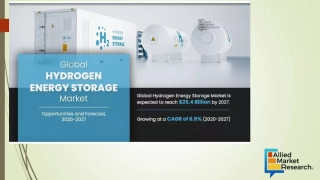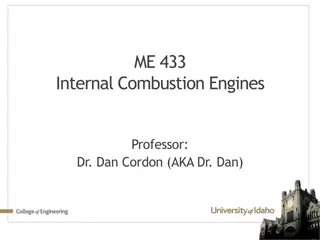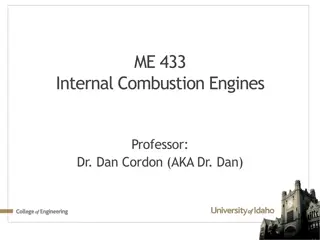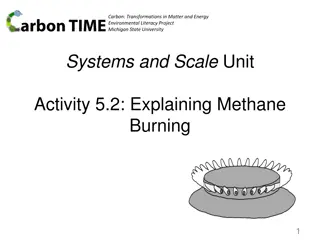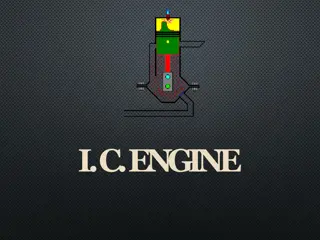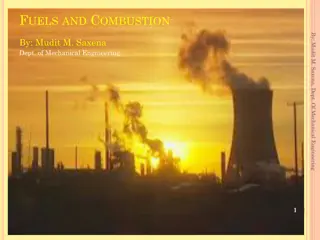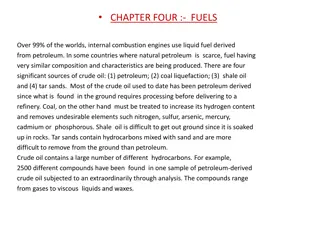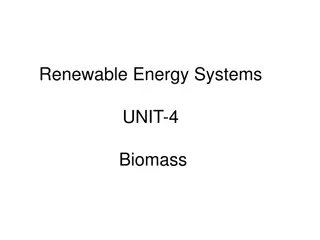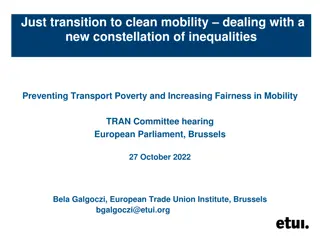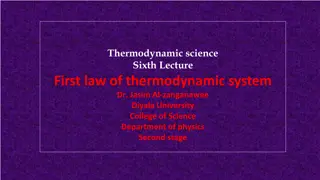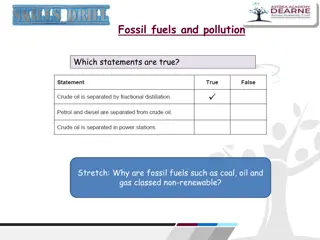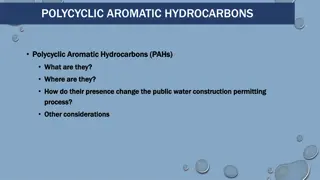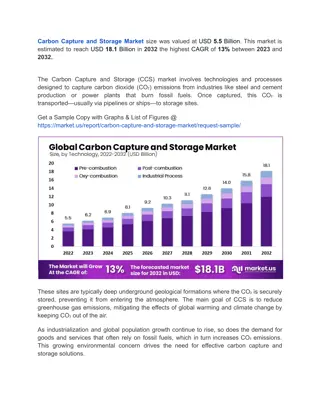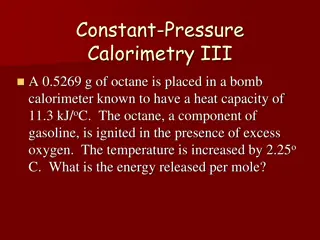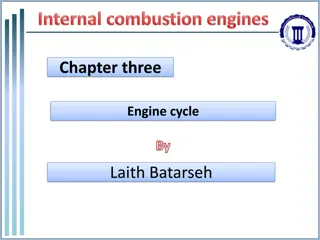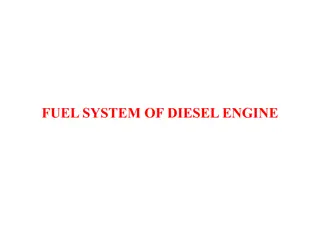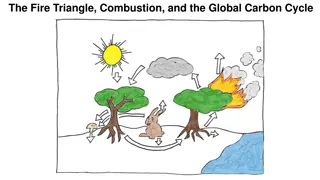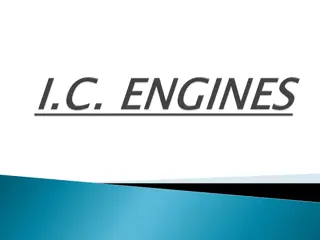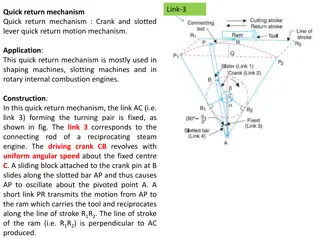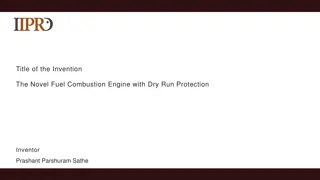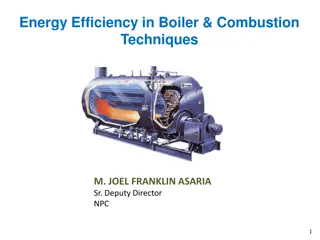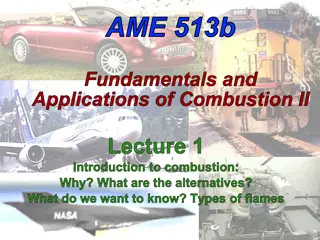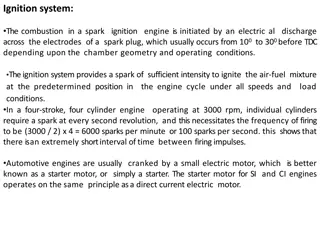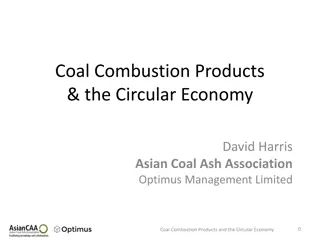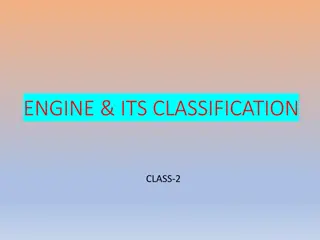Hydrogen Energy Storage Market
Hydrogen is produced through electrolysis of water and the gas is stored in medium or large sized containers according to the requirements. The gas can be converted into energy in combustion engine or in fuel cell. Usually, hydrogen energy is stored in three form; liquid, solid, and gaseous form. To
2 views • 6 slides
Advancements in Hydrogen Combustion for Internal Combustion Engines
Exploring the utilization of hydrogen as a sustainable fuel for internal combustion engines, this research delves into the mixing, combustion, and particulate formation processes in H2ICE. Discussions cover the benefits of hydrogen, challenges faced, and innovative solutions like onboard on-demand h
0 views • 21 slides
ERCOT CONE Study: Reference Technology Selection for Thermal Dispatchable Plant
The ERCOT CONE study focuses on selecting a reference technology for a thermal dispatchable plant in ERCOT, providing a basis for Cost of New Entry (CONE) calculations. The study reviews characteristics of existing and upcoming plants to determine the preferred technology. The proposed specification
3 views • 21 slides
Understanding Fuel Chemistry in Internal Combustion Engines
Fuel chemistry knowledge is crucial for internal combustion engines for various reasons such as determining air-fuel ratios, ensuring efficient combustion, preventing detonation, and optimizing power output. Balancing chemical equations, calculating specific volume for mixtures, and analyzing first
10 views • 19 slides
Understanding Mean Effective Pressure in Internal Combustion Engines
Mean Effective Pressure (MEP) is a crucial parameter in internal combustion engines, representing the average pressure exerted on the piston during the power stroke. MEP is relatively consistent for specific engine types, making it a useful predictor of torque output based on engine type and displac
10 views • 20 slides
Electric powertrain
The Electric Powertrain Market investigates the global shift towards electric propulsion systems in vehicles. It analyzes trends in electric motors, batteries, and power electronics driving the transition from internal combustion engines to electric powertrains.
0 views • 7 slides
Understanding Methane Burning: Chemical Transformations and Energy
Explore the process of methane burning through investigations and molecular modeling activities. Learn about the chemical changes involved, including the production of carbon dioxide and water. Discover the energy transformations that occur during combustion, with forms such as light and heat energy
1 views • 13 slides
Understanding Internal Combustion Engines: A Comprehensive Overview
Explore the intricate world of Internal Combustion Engines (I.C. Engine), including their classification, components, terminology, and operation cycles. Delve into the various types, arrangements, and applications of I.C. engines, from automobiles to aircraft engines, and uncover the key principles
1 views • 25 slides
Understanding Engine Cooling Systems
The cooling system in an engine is vital for maintaining optimal operating temperatures, preventing overheating, and ensuring efficient combustion. There are different types of cooling systems such as air cooling and liquid cooling, each with its advantages and disadvantages. Air-cooled engines rely
0 views • 23 slides
Exploring Fuels and Combustion in Mechanical Engineering
This content delves into the intricate world of fuels and combustion, discussing classifications, properties, and origins of various fuels such as solid, liquid, and gaseous. It covers the importance of desirable fuel properties, caloric values, and the different types of natural and artificial fuel
0 views • 34 slides
Understanding Fuels and Their Sources
Fuels derived from petroleum, coal, shale oil, and tar sands are crucial for powering internal combustion engines. Crude oil contains various hydrocarbons requiring refining processes to obtain products like natural gas, gasoline, kerosene, diesel oils, fuel oils, and lubricating oils. The chemical
1 views • 7 slides
Renewable Energy Systems - Biomass Energy Conversion and Applications
Biomass, a renewable energy source, is abundantly available in organic matter such as dried woods, leaves, and cow dung. Through photosynthesis, solar energy is converted into biomass energy. Different conversion processes including direct combustion, thermochemical, and biochemical methods are util
0 views • 30 slides
Just Transition to Clean Mobility: Addressing Transport Poverty and Inequalities in the Energy Crisis
The European Parliament discusses the urgent need for a just transition to clean mobility to tackle transport poverty and inequalities amidst the energy crisis. Bela Galgoczi emphasizes the multidimensional nature of environmental, climate, and social inequalities, urging for comprehensive policies
1 views • 8 slides
Understanding the First Law of Thermodynamics in Science Lectures
Explore the concept of the First Law of Thermodynamics through a series of engaging science lectures by Dr. Jasim Al-zanganawee from Diyala University. Learn about energy transfer, conservation, internal energy of ideal gases, and how heat and work impact a system's total energy. Discover the relati
0 views • 15 slides
Understanding Fossil Fuels and Pollution: A Comprehensive Overview
Fossil fuels such as coal, oil, and natural gas are non-renewable energy sources that release heat energy when burned, but also contribute to pollution when not burned completely. This leads to the release of harmful pollutants like carbon dioxide, carbon monoxide, sulfur dioxide, and carbon particu
2 views • 9 slides
Understanding Boiler Draught: Natural vs. Artificial Methods
Boiler draught is the pressure difference that facilitates airflow through a boiler to aid in combustion and heat transfer. Natural draught relies on chimney height and temperature differentials, while artificial draught involves external mechanisms. Both methods play crucial roles in boiler operati
1 views • 22 slides
Understanding Polycyclic Aromatic Hydrocarbons (PAHs) and Their Impact
Polycyclic Aromatic Hydrocarbons (PAHs) are ubiquitous environmental pollutants found in nature and from human activities like combustion. They affect public water construction permitting processes by influencing material standards. PAHs can be harmful concerning health when soils are disturbed duri
0 views • 6 slides
Understanding the Impact of Acid Rain on Ecosystems
Investigate the effects of acid rain caused by fossil fuel combustion on water acidity, plant life, animals, and structures. Learn how nitrogen oxides and sulfur dioxide create acid solutions in the atmosphere, affecting watersheds and sensitive ecosystems. Explore the devastating consequences of ac
1 views • 20 slides
High Costs and Safety Issues Challenge Carbon Capture and Storage Adoption
Carbon Capture and Storage Market By Technology (Pre-combustion, Post-combustion, Oxy-combustion, and Industrial Process), By End-Use Industry (Power Generation, Oil & Gas, and Other End-Use Industries), By Region and Companies \u2013 Industry Segmen
0 views • 4 slides
Evolution of Fishing Gear Technology: From Traditional Methods to Modern Innovations
Fishing has evolved from a traditional practice to an industrial activity with advancements in fishing gear, vessels, and preservation techniques. Mechanization, starting in the 19th century, led to the use of steam, internal combustion engines, and eventually diesel and electrical/hydraulic systems
2 views • 9 slides
Understanding Energy Changes in Chemical Reactions
Exothermic reactions release energy to the surroundings, exhibited in processes like respiration and combustion. On the other hand, endothermic reactions absorb energy, demonstrated in examples such as photosynthesis. By observing changes in temperature and reactions between various substances, one
0 views • 24 slides
Understanding Calorimetry and Enthalpy Changes in Chemistry
This content explores various concepts related to calorimetry, enthalpy changes, and Hess's Law in the field of chemistry. It covers topics such as energy released in combustion reactions, heat capacity, phase changes, and the application of Hess's Law in determining enthalpy changes. Enthalpy value
0 views • 17 slides
Fire Safety Measures in DC Metro System
Learn about fire safety in the DC Metro System, including the risks of combustion in composite materials, relevant safety specifications from various standards organizations, and essential fire safety measures such as detection systems, fire suppression, and emergency lighting. Explore the importanc
1 views • 23 slides
Understanding Engine Cycle Analysis
The engine cycle analysis delves into the intricate processes within a combustion chamber, simplifying the complex interactions of air, fuel vapor, and exhaust gases. Idealized assumptions help analyze the constant-pressure intake, compression, and expansion strokes, along with the combustion proces
1 views • 48 slides
Understanding the Fuel System of Diesel Engines
During operation, a diesel engine's fuel system plays a crucial role in delivering clean fuel to the combustion chamber. The system comprises components like fuel filter, fuel lift pump, fuel injection pump, atomizers, and high-pressure pipes. Proper maintenance is essential to ensure efficient oper
5 views • 12 slides
Understanding the Fire Triangle, Combustion, and the Global Carbon Cycle
This series of images explores the concepts of the fire triangle, combustion, and the global carbon cycle. It delves into the role of oxygen, fuel, and heat in combustion processes, leading to the production of carbon dioxide, water, heat, and light. The images further illustrate the chemical proces
1 views • 12 slides
Maximizing Biomass Sector Growth in Namibia through Thermal Processing Technologies
The Namibia Biomass Research Symposium 2023 emphasizes the potential of the Namibian biomass sector in igniting growth through thermal processing of encroacher bush-based biomass. With vast untapped biomass stocks and a focus on thermochemical and direct combustion technologies, the symposium highli
0 views • 12 slides
Overview of Electric Power Plants
Explore the functioning of various electric power plants including nuclear, fossil fuel thermal, hydroelectric, wind, solar, geothermal, biomass, and ocean power plants. Understand the processes involved in generating electricity from different energy sources such as fission, combustion, steam gener
0 views • 15 slides
Overview of Power Systems and Energy Generation
The power system encompasses generation, distribution, and transmission systems that convert various forms of energy, such as coal and diesel, into electrical energy. Energy cannot be created or destroyed but can only be transformed from one form to another. Generation involves converting primary en
3 views • 30 slides
Overview of Internal Combustion Engines and Their Components
Internal combustion engines are devices that convert fuel's chemical energy into thermal energy, which is then used to produce mechanical work. The engines can be classified into two types - External Combustion Engines and Internal Combustion Engines. Internal combustion engines include components l
2 views • 53 slides
Understanding Quick Return Mechanism in Machinery
Exploring the application, construction, and velocity analysis of the crank and slotted lever quick return motion mechanism commonly used in shaping machines, slotting machines, and rotary internal combustion engines. The mechanism involves fixed link AC, driving crank CB, sliding block, and short l
8 views • 14 slides
Understanding Small Gasoline Engine Performance
This chapter explores the intricacies of measuring and optimizing internal combustion engine performance, focusing on calculating functional horsepower through various formulas and measurements. It delves into the combustion process in a small gasoline engine, detailing how the air/fuel mixture igni
0 views • 66 slides
Understanding the Components and Operation of Internal Combustion Engines
Dive into the world of internal combustion engines through a detailed exploration of their classification, key components like cylinders, pistons, crankshafts, and crankcases, as well as the operational principles of four-stroke engines. Discover how these engines work, their construction, and the r
2 views • 103 slides
Novel Fuel Combustion Engine with Dry Run Protection
This invention by Prashant Parshuram Sathe addresses the crucial issue of preventing damage to fuel combustion engine pumps caused by dry running. The innovative mechanism stops fuel flow in the absence of fluid, preventing overheating and damage. Investing in this technology at an early stage offer
0 views • 10 slides
Understanding the Differences in Smoke Colors - Exploring the Science behind Black, Grey, and White Smoke
Smoke color can vary based on what is being burned, the level of combustion, and various other factors. Black smoke often indicates incomplete combustion of heavy materials, while grey smoke signals the fire settling down. White smoke is common at the start of a fire or with lighter fuels. By studyi
0 views • 11 slides
Energy Efficiency in Boiler & Combustion Techniques
This article discusses energy efficiency in boiler systems and combustion techniques, covering topics such as boiler types, classifications, specifications, and applications. It explains the process of heat generation through fuel combustion, transfer to water for steam production, and highlights va
0 views • 70 slides
Fundamentals of Combustion II - Introduction and Nomenclature
This lecture introduces the fundamentals of combustion by discussing reasons for studying combustion, alternative energy sources, and what we aim to understand. It covers different types of flames and provides a comprehensive nomenclature summary for the course, including various parameters and thei
0 views • 32 slides
Understanding the Ignition System in Internal Combustion Engines
The ignition system in spark ignition engines initiates combustion through electric discharge across the spark plug electrodes. It ensures proper ignition timing for efficient engine operation at various speeds and loads. Modern ignition systems include battery, magneto, and electronic ignition type
0 views • 21 slides
Coal Combustion Products & the Circular Economy - Addressing Resource Flow Challenges
This discussion delves into the intersection of coal combustion products and the circular economy, emphasizing the need for continuous re-evaluation of resource chains, ecosystem metabolisms, and industrial innovations to ensure sustainable environmental practices and economic growth. Exploring the
0 views • 24 slides
Understanding Engine Classification and Design
Engine classification involves categorizing engines based on various factors such as combustion type, number of strokes, cylinder design, and ignition method. Common classifications include external and internal combustion engines, as well as categories based on the design and use of the engine. Add
0 views • 11 slides
